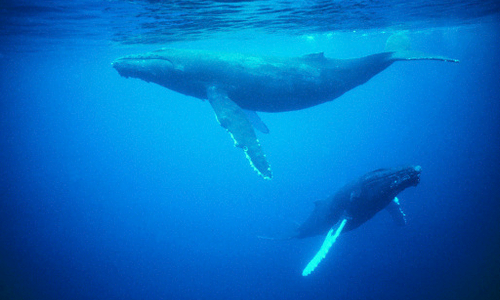15 Weird and Wonderful Facts about Whales
ANIMAL RIGHTS - VEGETARIANISM, 5 May 2014
Cherise Udell, Care2 – TRANSCEND Media Service
Whales are so obviously different from us, yet surprisingly similar in so many ways. They are extremely intelligent and social beings that share our lifespan and often our close-knit family structures. They sing, they play, they nurture, they bond and they cooperate. However, unlike modern humans who appeared on the scene less than 200,000 years ago, modern cetaceans are an ancient clan stretching back tens of millions of years. These cetaceans first appeared in the fossil record about 50 million years ago (in modern form about 35 million years ago) and have been populating our oceans with a magical grace ever since. Below are 15 little-known, yet very interesting facts about the dozens of whale species that share our world.
1. The closest living relative to cetaceans (whales and dolphins) are hippos.
2. Sperm whales have bizarre sleep habits.Whole pods have been observed sleeping with their bodies completely vertical to the ocean floor with their heads bobbing at the surface. It is believed (but not entirely understood) that sperm whales dive to the ocean floor to nap, but during this nap time they slowly rise to the surface head-first. These naps appear to last no more than 12 minutes and oddly only take place between six p.m. and midnight.
3. The tusk or horn of the male narwhal is actually an oversized canine tooth. The tooth pierces the left lip, growing throughout life up to 10 feet long. This fancy oversized tooth is jam-packed with nerve endings and grows in a left-handed helix spiral. Oddly, about 15 percent of female narwhals also have tusks. Some of the first narwhal teeth (or tusks) to reach Europe were touted as being the horns of the mythical unicorn.
4. The blue whale has the largest penis in the world at about eight feet long, but not the largest testes. That award goes to the Southern Right whale. One pair of Southern Right whale gonads weigh about one ton.
5. The head and lower jaw of humpback whales are covered with knobs called tubercles, which are actually hair follicles.
6. The largest animal to ever grace our planet, living or extinct, is the blue whale. Blue whales have tipped the scales at 140 tons and reached 100 feet. The blue whale tongue alone can weigh as much as an elephant.
7. Not surprisingly, the blue whale also boasts the largest heart in the world, which is about the size of a VW Beetle and weighs up to 1,000 pounds. The aorta attached to this super-sized heart is is big enough for a human child to crawl through.
8. Sperm whales are super-divers. They love squid, so to dine on their favorite delicacy they must dive deep and hang there for awhile while hunting. Adults can dive to depths of 2,000 meters and stay submerged for almost two hours.
9. Fin whales pee the equivalent of about three bathtubs per day.
10. Orca whales are not whales, but actually dolphins. They are found in every ocean from the icy Arctic to the warm waters of the tropics and are considered one of the smartest animals on our planet.
11. Blue whales are pregnant for nearly two years.
12. A newborn blue whale calf weighs about as much as 100 men and is about 7.5 meters long. This huge baby drinks enough fat-rich milk to fill a bathtub every day. This milk is 40-50 percent fat and has the consistency of cottage cheese. With all of this nursing, baby blue whales gain 3.7 kilograms an hour, until about eight months-old. By then, they typically weigh 22.5 tons.
13. Most whales give birth surrounded by midwives. The midwives help the newborn stay at the surface for breathing, while the mother recovers.
14. Gray whales migrate astonishingly long distances between their winter calving lagoons in Mexico and their summer feasting grounds in the Arctic—about 10,000 to 12,400 miles round-trip every year.
15. Blue whales can boast of being the loudest creatures on Earth. At 188 decibels, their loudest vocalizations can be heard hundreds of miles away and is louder than a jet, which peaks at only 140 decibels. Human ears cringe at sounds over 120-130 decibels.
You Also Might Like:
International Court Rules Japan’s ‘Research’ Whaling Illegal in Landmark
Study Finds Proximity to Offshore Oil and Gas Drilling Rigs Threaten Humpback Whales
Whales Desert Historic Feed Grounds—Is Climate Change to Blame?
DISCLAIMER: The statements, views and opinions expressed in pieces republished here are solely those of the authors and do not necessarily represent those of TMS. In accordance with title 17 U.S.C. section 107, this material is distributed without profit to those who have expressed a prior interest in receiving the included information for research and educational purposes. TMS has no affiliation whatsoever with the originator of this article nor is TMS endorsed or sponsored by the originator. “GO TO ORIGINAL” links are provided as a convenience to our readers and allow for verification of authenticity. However, as originating pages are often updated by their originating host sites, the versions posted may not match the versions our readers view when clicking the “GO TO ORIGINAL” links. This site contains copyrighted material the use of which has not always been specifically authorized by the copyright owner. We are making such material available in our efforts to advance understanding of environmental, political, human rights, economic, democracy, scientific, and social justice issues, etc. We believe this constitutes a ‘fair use’ of any such copyrighted material as provided for in section 107 of the US Copyright Law. In accordance with Title 17 U.S.C. Section 107, the material on this site is distributed without profit to those who have expressed a prior interest in receiving the included information for research and educational purposes. For more information go to: http://www.law.cornell.edu/uscode/17/107.shtml. If you wish to use copyrighted material from this site for purposes of your own that go beyond ‘fair use’, you must obtain permission from the copyright owner.
Read more
Click here to go to the current weekly digest or pick another article:
ANIMAL RIGHTS - VEGETARIANISM:

